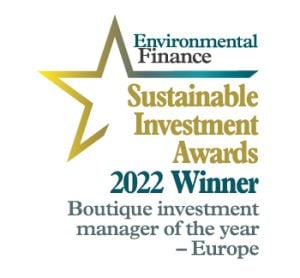We are delighted to win this year’s Boutique Manager of the Year Award

Write up from Environmental Finance
NB: The Environmental Finance Awards are free to applicants and open to all organisations globally.
Osmosis used a proprietary environmental database that it developed to find and tilt its portfolios towards resource-efficient companies.
The database works by collecting and standardising the relevant corporate environmental disclosures on carbon emissions, water consumption, and waste generation. The methodology then takes these key resource efficiency indicators to make investment decisions as, Osmosis argues, it identified early on that resource efficiency could be used as a predictor of firm value and an independent source of alpha. This research is corroborated by robust statistical evidence over time across economic sectors and geographic regions.
The firm also seeks to set itself apart by only assessing actions a company has taken that feeds through to their environmental balance sheet.
“The past year has been challenging for many sustainable investment funds [but] our focus on resource efficiency has continued to deliver in this challenging macro environment, which has resulted in the on-boarding of new clients from Australia, Brazil, North America, Europe and the UK and seen assets grow significantly,” said Ben Dear, CEO and founder of Osmosis.
Over 18 months, to the end of May, the investment manager has grown its assets under management by 144%.** This was done in part by winning mandates from an Australian Government Pension Scheme and the East Sussex Pension Fund.”
About Osmosis
A unique sustainable factor based on Resource Efficiency
Identification of a sustainable alpha signal is a challenge solved by only a few in the ESG space.
The Resource Efficient Core Equity Fund launched following extensive research, correlation and attribution analysis on our proprietary Resource Efficiency Factor. Developed over 12 years, our proprietary and objective environmental research process enables the identification of those companies that are better placed to deal with the increasing number of environmental challenges that lie ahead. At the same time, those companies that refuse to change or are too slow to adapt will continue to destroy shareholder value.
Managing active & environmental risk
All portfolios seeking a sustainable outcome will naturally bring in active risk relative to a market-cap-weighted benchmark. The Osmosis program is unique in that the active risk is controlled and targeted towards a sustainable alpha signal.
Our goal was to ensure that when investors seek to reduce their portfolio’s environmental footprints, the risk that they assume is not left unrewarded. Our core strategies aim to deliver better risk-adjusted returns than the respective benchmarks by tilting the portfolio towards stocks we have identified as more resource-efficient and thus more likely to outperform their sector peers. All the strategies deliver the main benefits of index investing by offering a highly diversified and cost-efficient portfolio.
Research has evidenced that Resource Efficiency is a return signal independent from traditional country, sector, size and style factors. The allocated risk budget is targeted towards resource efficiency through the idiosyncratic part of the risk models, risk that is usually diversified away. Through this smarter management of the active risk, the core strategy can replace the MSCI World without impacting existing exposures and enhancing the risk-adjusted return.
A broad economy approach
When we launched in 2009, we were the first sustainable asset manager to focus on a broad economy solution. We recognised that addressing supply was only meaningful in the context of addressing demand. This Fund was developed to appeal to investors from institutions to individuals who shared our conviction that a well-diversified global portfolio, targeting overweight and underweight positions to environmentally efficient and inefficient companies across the broader economy, would result in improved portfolio returns.
A significant environmental impact
The outcome of this sophisticated core replacement strategy is a significant reduction in the portfolio’s environmental footprint. The strategy delivers significant reductions in ownership of Carbon (61%), Water (68%) and Waste (77%) (as of 31 May 22) relative to the benchmark while remaining invested across the broader economy.
Osmosis believes that the planet’s long-term sustainability demands a re-evaluation of overall resource consumption. Carbon, Water and Waste, are each subject to increasing regulation, cost pressure and social scrutiny. Companies focused on environmental impact need to address those aspects of consumption and pollution that are most relevant to their business model, which will often include the mitigation of resources other than Carbon. Osmosis’ research demonstrates that this three-factor approach also delivers a more reliable investment signal.
Important Information
* The foot printing metrics above have been calculated using a Total Metrics approach, apportioning carbon emissions, water consumption and waste generation to the investor based on an equity ownership perspective. Calculating the “owned” emissions, water and waste from each position in the portfolio and benchmark, and adding those metrics yields the total impacts for the portfolio. The calculations have been based on metrics recorded in the MoRE DataBase where available, and industry averages have been used to estimate any gaps in the data coverage.
** As of 31 May 2022 – Osmosis Investment Management UK Ltd (“OIM UK”) is an affiliate of Osmosis Investment Management US LLC (“OIM US”). Osmosis Investment Management AUM includes discretionary assets under management of OIM US and OIM UK and assets invested in model programs provided by OIM US and OIM UK.
The MSCI World Index captures large and midcap representation across 23 Developed Markets.



